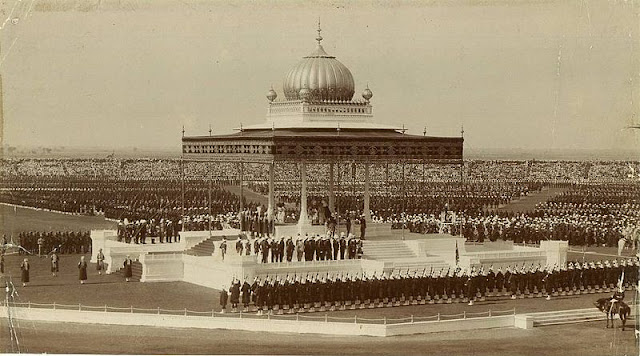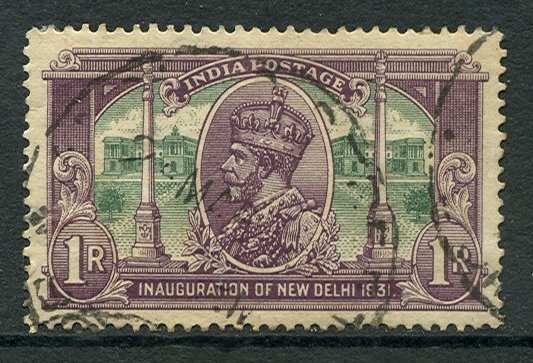The magnificent Delhi Durbar 1911. King George the Fifth declared at this Durbar that the capital of the British Raj would be shifted from Calcutta to Delhi
Source - Wikipedia
The Britishers did not do anything unique by announcing to establish their new capital at New Delhi, they were simply continuing with the traditions of previous pan-India Hindu (Indraprastha), Islamic (Tughlaqabad) and Mughal (Shahjahanabad) rulers who had established their capitals over here.Source - Wikipedia
The Delhi Durbar was held amidst great pomp, splendour and excitement as the picture suggests; held in the middle of vast barren dusty plains of North Delhi. The selection of the place was not co-incidental as on the very grounds the Durbar's of Queen Victoria (1877) and King Edward the Seventh (1903) were held. Moreover, near this very spot, the British had won a crucial victory over the rampaging Indian armies taking part in the Sepoy Mutiny (Indian War of Independence) of 1857, so the place had special value for them.
This obelisk was erected at the exact place where the King and the Queen sat in Durbar of 1911
The Commemoration Plaque under the Obelisk
Since that fateful day the city of New Delhi has come a long way. The British and (later) Indian capital of New Delhi was built by architects Sir Edward Lutyens and Sir Herbert Baker. The construction of the city began only after the First World War ended (1919) and was completed by 1931. The landmark buildings constructed by Lutyens in New Delhi were All India Memorial(India Gate), Viceroys House(Rashtrapati Bhawan), the Parliament, Central Secretariat, the Lutyens Bungalow Zone (which houses current M.P.s of India) e.t.c.
This postal stamp was issued by the Imperial Post Office over the inauguration of New Delhi on 1931 A.D.
Till date the portion of the city of Delhi which Sir Edward Lutyens constructed is called as Lutyens Delhi.
The statue of King George the Fifth. This statue was originally located right next to the India Gate from where it was removed in the 1960s and placed opposite the Obelisk at Commemoration Park.
Following are the pictures of 'Lutyens' Delhi' or the portion of the city which Sir Edward Lutyens completed in 1931. The names of the buildings in the British Era are given in brackets wherever required -
India Gate or the All India Memorial (as called by the British) (at night). This memorial was constructed to honor the Indian soldiers who died fighting for the British Crown in the First World War (1914-1919)
Parliament of India
Rashtrapati Bhawan (Viceroy's House)
Picture Source - Wikipedia
Picture Source - Wikipedia
A view of Raj Path (King's Way). The way stretches from Rashtrapati Bhawan to India Gate. The parade on Republic Day(on 26th January) takes place over here.
Raisina Hill which hosts the Central Secretariat (North Block - Right, South Block - Left). Notice the Jaipur Column in front of the Central Dome. The Raj Path (Kings Way) starts from this point.
This lamp post is a reminder of the colonial times. In the backdrop is the bell tower
of the North Block of Central Secretariat.
A street in Lutyens Delhi. Streets in this portion of Delhi are known for their immaculate planning.
This week onwards I would on every Tuesday post a special article over Delhi which would cover city's history and the present. I would prefer to name the weekly series of articles as Delhi-teful Tuesdays. Happy Reading !
You can now join our Facebook Page for beforehand information and exclusive pictures. 




















0 comments:
Post a Comment